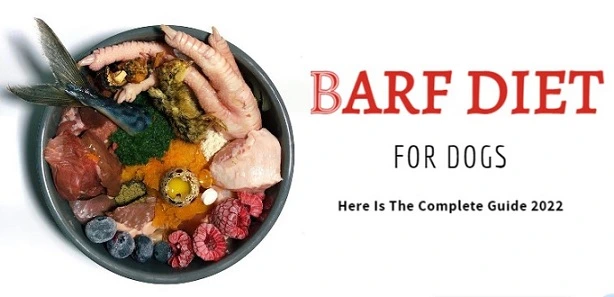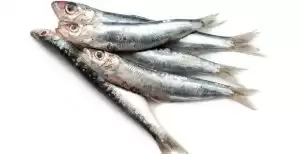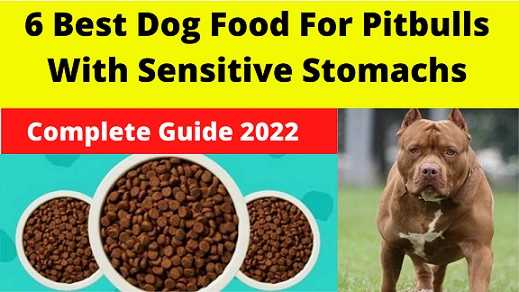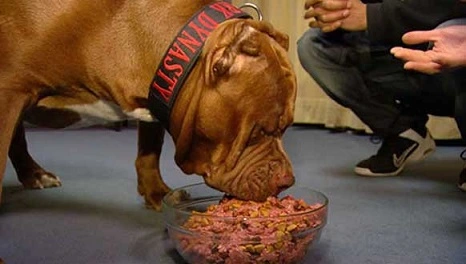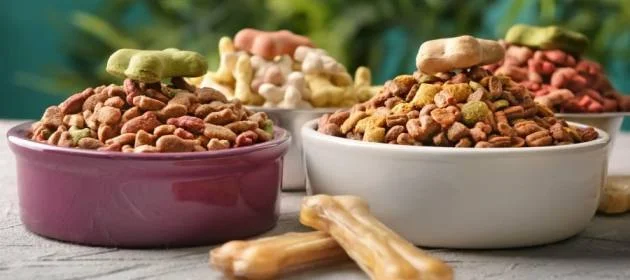Barf Diet For Dogs | What is Barf Diet For Dogs | How to make Barf Diet For Dogs
When we begin to approach this diet,
we ask ourselves how to set up a barf diet for dogs and how much meat should be given.
Some people even decide to give up because they consider it complicated, but if you are in no hurry, we will review everything carefully.
I have seen several theories on the web over the years, some recommended a direct step by mixing kibble and meat, others recommended 24-hour fasting and still others recommended cooking.
By carefully reviewing various passages with the pros and cons that you have, I opted for very precise choices. Now I will explain to you what they are.
First of all, if you don’t know what is barf diet for dogs? Then let me tell you.
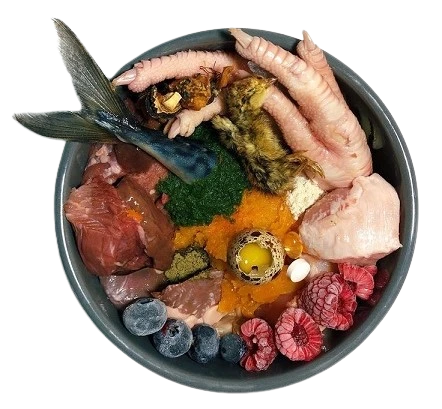
Barf Diet For Dogs
BARF is a correct feeding system, biologically appropriate with respect to the nutritional peculiarities of the dog.
The BARF diet consists of what the dog would eat in nature if he went hunting: raw meat, vegetables, eggs, vitamins, and minerals.
The products of the BARF CIAM-Dr. Clauders are inspired by natural nutrition, referring to their origins.
If you need more detail about the barf diet for recipes then you must read this article Barf Diet For Dogs -Best 6 Recipes, Advantage & Disadvantage
How do start my dog on the barf diet?
Mixing croquettes and meat in the step is definitely wrong !! Let’s see why.
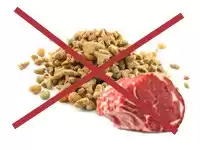
All raw foods contain a percentage of carbohydrates ranging from 0 to 15% but are starch-free; instead in the croquettes, there is a presence that varies from 30% to a maximum of 60%.
Some industrial lines have chosen to add it through starch and through complex carbohydrates such as rice, corn, and cereals, while other lines have chosen to add STARCH in a vegetable form such as peas or potatoes.
The starch contained in the kibble allows the pH of the stomach to increase the enzyme called Pepsin which is responsible for breaking down the protein in food and its blocks, amino acids.
Pepsin itself, however, is released only if the pH is lower than 2, so the same predigestion will not occur if there is starch inside the stomach which increases its value.
If this value is accidentally increased, you have less acid, and bacteria like Escherichia Coli (E.Coli) and Salmonella are more likely to survive, causing digestive problems or any digestive upset.
Once the ingested food leaves the stomach, the pH itself triggers the release of pancreatic enzymes that carry out the digestive action, but if instead, we find the presence of starch inside, the pH rises and fewer enzymes will be released.
Food particles, on the other hand, not subjected to digestion, can trigger an inflammation called lost bowel syndrome. (Although it is a definite rare syndrome)
This syndrome can allow food and bacteria themselves not to pass through the wall of the small intestine, where they cause immune disturbances upon entering the body.
This is the reason why the choice to mix the croquettes with the raw is wrong and does not correspond to a good rule on how to start a barf diet.
Even more harmful if OPs (Pulpy Bones) are integrated into the presence of little acid in the stomach because your pet will not be able to digest them properly, causing poor absorption of the necessary minerals from the bone, and a greater risk of intestinal obstruction and perforation.
Fasting before making the switch
Correct !! Let’s see why.

Fasting for 24 hours allows your pet’s organs, such as the kidney and liver to cleanse themselves of any waste accumulated by the digestive system, for a physiological enzymatic rest of the pancreas. This is a discourse that we can deal with with a healthy dog, in full shape of life, and not with a puppy or an elderly person.
Just anticipate the meal of the day before and delay the one the next day in this way more hours will pass between one meal and another.
I’ll give you an example; s and your dog eats punctually at 07.00 in the morning, the fast will be done like this: 1st-day feed at 7.00 am (Industrial food) – 2nd-day feed at 7.00 pm (Raw food) like this you have left a time of 36h (removing the industrial digestion time, which has an average of 12h, you get 24h of complete fasting) between one meal and another. Without realizing it, you have started a new diet.
Fasting on puppies or older dogs
Wrong !! They risk hypoglycemia.

Hypoglycemia means a lowering of the blood glucose concentration below a threshold value that is not yet exactly determined, but which is conventionally considered 70 mg/dl, a level below which the body starts the secretion of counter-regulatory hormones.
The transition is carried out by cooking, only in this way you do not cause any reaction.
Cook the meat before making the switch
Correct !! Let’s see why.

The cooking is inserted in a passage with animals that have a sensitive digestive system, such as gastritis, and with those that have pathologies of the intestinal tract, such as Gastroenteritis, IBD, and Colitis.
Blanch the meat for a few minutes, put it in the bowl, add some natural or freeze-dried probiotics and administer at room temperature. You may encounter a common problem such as diarrhea.
This is because until now they have always been used to an industrial diet and have not developed optimal digestion to assimilate natural food.
Your pet is eating completely natural food, without the presence of additives, appetizing but above all, there are no extra thickeners that will compact its feces as in an industrial food ( for this reason a dog fed with industrial food “seems” feel good by viewing the feces ). So very carefully accustom your pet to a raw diet.
I remind you of the correct way how to start a barf diet:
1st day of natural diet: blanch CSO (Meat without Bones) for a few minutes in water without salt, this process you do for 1 week, 1 month until it is assimilated correctly (every dog has its own times, not all are the same ) Once assimilated correctly, proceed in reverse, 1 week, 1 month to digest it raw.
A very important thing is that the Dog requires a slower passage than the Cat, which goes from 2 – 4 months but sometimes even years if the passage is carried out in the presence of some problems such as Gastroenteritis, IBD, Colitis, or any diseases.
This means that in a barf diet for dogs until you have included all the components that make up a 100% bowl you will have to include a complete supplement as a nutritional aid.
- Mineral salts.
- Soccer.
- Omega-3
1st step of the barf diet for dogs: CSO
CSO = ( Meat without Bone ) Recommended percentages: 25% – 50%
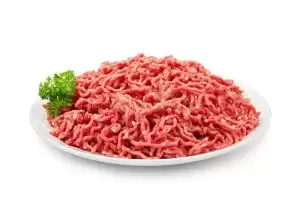
Meat without bone is inserted in rotation. Rotation is done not because there is one protein better than the other, so all are important and essential.
They also wouldn’t always eat the same things in nature. This is because moving from area to area the prey to be hunted is never the same and in this way, all the nutrients necessary to stay healthy are obtained.
If only one protein is used, the desired result is not achieved but all the nutrients that other animals can offer are lost.
Once a week, every ten days, change your protein source. Observe how it is assimilated and if it is assimilated correctly change the protein with a new one, in this way you will have the opportunity to try them all and discover any intolerances.
Meat is generally rich in proteins with high nutritional value, as well as containing important minerals such as iron, potassium, phosphorus, magnesium, zinc, and B vitamins.
In the barf diet for dogs, we have different meats, which I will list below.
White meat
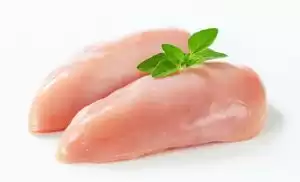
White meats are characteristic of some birds such as chicken, hen, rooster, cockerel, capon, guinea fowl, turkey, and domestic duck. The meat of some younger animals is also classified as white meat, as in the case of lamb, or kid. The rabbit also belongs to this category.
Generally, white meats are often recommended by nutritionists in the barf diet for dogs due to their high protein intake and low-fat content; they have few calories but are precious vitamins such as B12 and branched-chain amino acids essential for the proper functioning of the body.
Red meat
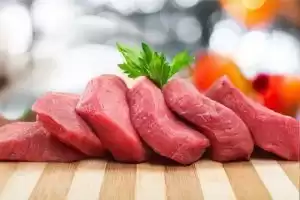
Red meats are obtained from adult animals such as beef, cows, bullocks, and other cattle that have reached maturities such as buffalo, horse, foal, sheep, and goats, and have higher amounts of myoglobin.
This category also includes pork and veal which are gastronomically considered pink meats. The greatest amounts of myoglobin are concentrated in the muscles of those animals that face considerable muscular effort.
Let’s take the example of chicken meat which is much lighter than beef or horse. The latter two strain their muscles much more. The difference between white and red meat also depends on the age of the animal: the older ones have myoglobin in greater quantities than younger animals.
Myoglobin is a small globular protein whose main task is to carry oxygen to the mitochondria present in the cells of the muscle tissue. As a result, it is found in large quantities in the heart and other muscles. Its color is red, a shade given by the presence of an EME group.
Hemoglobin carries oxygen to most of the body, while myoglobin traps oxygen in the muscles, to allow cells to work properly. When the heart or other skeletal muscle is damaged, myoglobin is released into the blood.
Black Meat
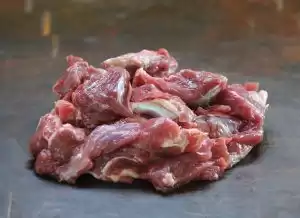
The game falls into the category of so-called black meats, such as hare, roe deer, wild boar, chamois, bison, elk, deer, ostrich, pheasant, partridge, woodcock, quail, and wild duck. The fat content is low, but the muscle fibers are much harder than other types of meat.
The heads of wild game eat what nature offers them, they are very active in the muscles which characterize their low-fat content. Additionally, eating vegetables in nature contributes to a lower content of omega-6 fatty acids which are pro-inflammatory, and a higher content of omega-3 fatty acids which are anti-inflammatory.
Wild game meats tend to be low in fat and be healthier than pets fed intensively on wheat and other grains such as corn.
Feeding corn and wheat to farm animals not only increases the total fat content but also the content of omega-6 fatty acids. According to the Linus Pauling Institute, omega-6 fatty acids increase inflammation states in the body.
According to the Encyclopedia of Healing Foods, game meats, such as venison, have a higher content of omega-3 fatty acids than grain-fed beef and corn. Grass-fed beef or bison have a higher content of omega-3 fatty acids.
All this is established by the animal’s own diet if it feeds freely with grass, leaves, and berries it will have a higher omega-3 value if it is fed with cereals, corn, and wheat as often happens in intensive farming then it will have a higher omega-6 value.
As we have seen, the most digestible meat is White, so I always advise you to start with this sequence: White – Red – Black.
2nd step of the barf diet for dogs: Pulpy Bone
Recommended percentages : 10% – 30%
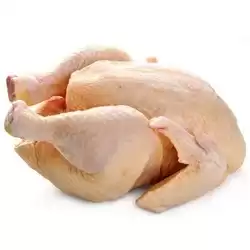
Which bones should I use?
I will try to explain it to you in a simple way by giving an example with the OPs of a rabbit.
The rabbit is an animal with very soft bones, but if we carefully study the anatomical part of the rabbit we see that the animal has supporting bones that support it, the hind legs.
These bones are more resistant than the anterior bones and the carcass because it has the ability to hold the animal on two legs, allowing it to give it the push to jump and run so that anatomically the posterior OPs are thicker than the rest.
We have to use some intelligence in understanding that if I have just started this feeding I will never give the rabbit’s head since anatomically it is a harder OP source that the animal presents, but I will start to use them gradually in the form of ground.
We will use a very soft cutout such as the front legs, a carcass with pulp around it, the hind thighs, and finally the head.
(I repeat carefully, this is an example you need to think about the bones to use for a neophyte dog, a dog accustomed to this diet, which has been doing it for some time, several years and which digests OPs very well, can also use a head, so learn to observe the anatomical part of the animal itself and think about the bones that you can offer to your animal.)
OP Ground
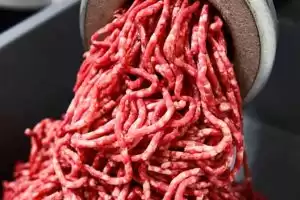
The first step can be done easily with a ground OP, the bones are already chopped so they will be very digestible for the animal that will use them, gradually forming and then moving on to the whole pulpy bones.
You can find OPs in well-stocked Barf stores and you have a wide range of animal origins to rotate, always observing carefully how it is assimilated.
You can use Quail, Rabbit, Chicken, Turkey, Guinea Fowl, Duck, Hen, and other volatiles.
Soft meaty bones
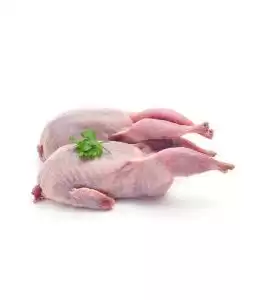
The pulpy bones must always be used observing the size of the dog you have. If I have a small dog I will use smaller clippings that are well within his reach, if I have a medium / large dog I will never use small bones but I will use bones within his reach, to allow the dog to properly chew the bones first swallow them and not swallow them directly causing unwanted risks.
You can use soft meaty bones such as:
chicks, mainly males, are born from farms that produce laying hens. They are killed at one day old and having been killed very early they do not get the right amount of calcium so they are poor.
They are very tender and small animals so they are an excellent food for those who have just started (the plumage is expelled through the feces, it is not assimilated).
quail anatomically is a very tender prey so portion it in the correct size of your dog, Wings, Back, and Thighs.
Rabbit, from which front legs, carcass, and thighs are used
Chicken, Chicken Necks, Single Wings and Bats (Bats for the uninitiated are the piece of joined wings and backs,) Backs, Carcasses, Thighs.
- Don’t overdo it using necks, esophagus or trachea can put your pet at risk of developing hyperthyroidism.
Hyperthyroidism, also known as thyrotoxicosis, is a condition in which the body experiences an overproduction of a thyroid hormone called thyroxine. This condition is generally present in older cats and is rare in dogs.
In dogs, it is usually caused by a tumor on the thyroid gland, but it can also be caused by ingesting excess thyroid hormone in the diet.
The thyroid gland that produces this hormone is located near the top of the neck, under the jaw.
When an animal consumes the neck, esophagus, or tracheal products containing thyroid hormones, the hormones are not destroyed by stomach acid or enzymes during digestion, so they are absorbed by the body.
This means that a diet that contains an excessive amount of thyroid hormone can cause hyperthyroidism.
Turkey is an animal with a glassy, honeycomb bone structure. There is a risk that the bone will break at a point, so it is advisable to use only the turkey neck. The turkey neck has very long size and is recommended for a medium to large size dog, so do not cut its size because you risk that your dog instead of chewing them will try to swallow them whole, so be careful.
Finally, with those of Guinea fowl – Duck – and the remaining Birds, Wings, Backs, Carcasses, and Thighs are used.
OP Hard
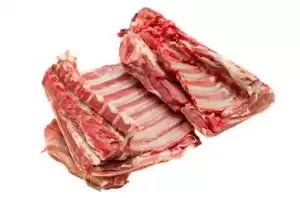
They are recommended to a dog who has had the opportunity to follow the right steps and is, therefore, able to chew and has formed correct assimilation.
The OP Dure present themselves include:
The head of Lamb and Rabbit mainly but, we cannot exclude that also the heads of Turkey, Duck, Guinea fowl, and the rest of the medium-sized birds. The ribs are also considered OP Hard; Lamb, Sheep, Pig
- Load-bearing bones such as Bovine Shank, Beef Knee, etc. .. cannot be considered pulpy bones, many use them as recreational bones, I always advise against them because they can easily encounter two main problems: broken teeth and intestinal obstructions. The supporting bones are anatomically huge, they are structured to support an animal over 700kg for a female bovine and over 1000kg for a male bovine, so you can only imagine how tough and tough they must be.
One last very important thing is never and I say never cook or boil OPs (pulpy bones), cooking makes the texture of the bones less elastic causing cuts in the mouth, gums, along the intestinal tract and the rectum finally can cause obstructions.
3rd step of the barf diet for dogs: Fruits and Vegetables
Recommended percentages : 10% – 15%
Now let’s see carefully how to introduce them and if they are cooked or raw.
The necessary cooking process, although it somehow facilitates digestion, partially “destroys” this scaffolding of which the plant cells are provided, hydrating the structure, and tends to make the simple sugars present more available, increasing the glycemic index of the food.
Instead, giving them raw and pureed increases the attack surface for the intestinal microflora, without altering the glycemic index, therefore a small amount of fiber is necessary for the correct functioning of intestinal mucosal cells that will contribute to the well-being of the whole organism.
Finally, they are excellent for diabetic animals, they are able to increase the sense of satiety, and obviously, constipation phenomena arise.
You can integrate all the vegetables except onion, shallot, leek, tomato, and eggplant.

Onion has an oxidizing effect resulting in anemia and we know for sure that onion, leek, and shallot can cause the onset of a condition known as Hemolytic Anemia, which can be not only extremely expensive to treat, but also fatal for the animal.
The toxic elements contained, especially thiosulfate, can literally destroy your pet’s red blood cells. These blood cells are essential for transporting oxygen to your dog’s organs, as well as to the brain.

Tomatoes and Eggplants contain Solanine, which is a toxic glycosidic alkaloid found in plants of the Solanaceae family. Vegetables belonging to this family are potatoes , aubergines, and even chilli, and peppers . Tomatine is also dangerous for dogs and can lead to heart damage.
Tomatin is found in the stem and leaves of tomatoes. The quantity that must be ingested, however, must be quite abundant but this does not mean we can be calm and include it in his diet.
Fruit
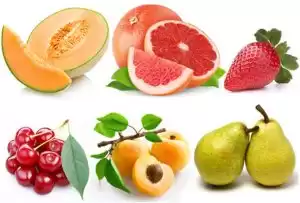
Beware of fruits with too large stones (such as peach and apricot), as the dog may choke and many of these may contain cyanide.
Be careful not to give grapes, it is toxic to dogs, if consumed in large quantities it could cause serious damage to the kidneys. Its consumption in small quantities can cause diarrhea. There are some dogs that do not exhibit severe symptoms after consuming grapes, but it is always best not to take risks.
You can always integrate all the fruit in moderation as it is sugary, so animals with diabetes problems are advised to take it very carefully.
Fruits: Banana, apple, pear, mango, papaya, melon, watermelon, mandarin, orange, apricot, kiwi, cherries.
Vegetables
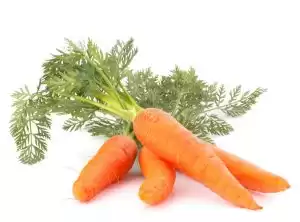
Dates in moderation: spinach, chard, cabbage, broccoli, avoid giving it to dogs suffering from gastritis, as it is rich in oxalic acid.
NON-STARCHY VEGETABLES (low glycemic) green leafy vegetables, summer squash, courgettes, green beans, celery.
STARCH VEGETABLES (highly glycemic) carrots, winter squash, peas, potatoes (cooked), parsnips, Swedish turnips, and beets.
Possible vegetables (never exceed any type of vegetable) are asparagus, chard, broccoli, artichokes, cabbage, green beans, turnips, spinach, courgettes, cucumbers, and endive salads, escarole, lettuce, curly salad, radishes only the leaves, and celery, fennel, carrots.
GREEN LEAF VEGETABLES: they are sources of fiber, folic acid, riboflavin, vitamin A, beta-carotene, vitamin C, E, and K, do not abuse them.
- Pay attention to peas and green beans because, despite having nutritional characteristics similar to those of vegetables, they are legumes.
4th step of the barf diet for dogs: ORGANS
Recommended percentages : 10% – 15%
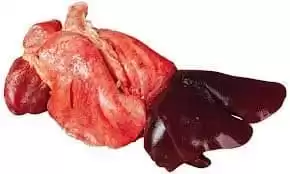
The Liver – Recommended percentage: 5%
Believed to be one of the most concentrated sources of natural vitamin A. This vitamin maintains the health of the reproductive organs, contributes to the maintenance of vision, and is a powerful antioxidant. The liver contains many B vitamins, especially folic acid and vitamin B12, which help maintain mental abilities, and nervous system health and prevents anemia.
In addition, this organ contains one of the best sources of iron available, which is usable by the body of our dogs (and ours). Iron is needed to form hemoglobin that carries oxygen in the blood, for brain development and function, to regulate body temperature, and for muscle activity. It is also rich in biotin, copper, iron, B vitamins and also contains a lot of glycogen.
For this reason, the liver must be given in moderation, an overdose of vitamin A can create serious problems.
The heart
Being an organ muscle, it sometimes resembles meat but is heavier and denser than a muscle. It is an organ rich in proteins and unique nutrients, such as Coenzyme Q10. This nutrient is necessary for the performance of basic cellular functions and to optimize the heart rhythm, participates in the production of energy needed by cells and the heart, and is believed to be a powerful antioxidant.
Kidney
It is an offal that contains few fatty acids (although mostly saturated). The kidneys bring almost all the mineral salts in excellent quantities, to say the least; iron, selenium, and zinc are particularly appreciated (the latter boast a high antioxidant power). From a vitamin point of view, kidneys are rich in water-soluble and fat-soluble molecules.
Among the fat-soluble ones, vitamin A (retinol) and vitamin D (calciferol, very rare) stand out, while among the water-soluble ones there are excellent quantities of thiamin, riboflavin, niacin, biotin, etc. (i.e. almost all the molecules belonging to group B).
Brain
It is a food rich in vitamin B5 and 100g of this meat contains 2.30 ug. vitamin B5. calf brains are among the low-sugar foods because this food is sugar-free. Vitamin B5 or pantothenic acid, which is found in abundance in the beef brain makes this a great food for fighting stress.
Tongue
It is a highly energetic food whose composition seems similar to a very fat cut of muscle. From a vitamin point of view, it is very rich in iron), potassium and phosphorus. As far as vitamins are concerned, the water-soluble ones of group B stand out, in particular thiamin (vit. B1), riboflavin (vit. B2) and niacin (vit. PP) .
Sweetbreads
They include the salivary glands, the thymus, and the pancreas and are easily digestible food, rich in vitamins and minerals (phosphorus in particular).
Lungs
Essentially protein in nature (it contains about 14% protein), with a limited presence of fats (2%), it is a poorly digestible food due to its too compact structure, so always test the digestibility of your animal before feeding it as a complete meal.
Spleen
It can be defined as a low-calorie food and together with the liver, it is the richest iron offal.
The Breasts
They are not recommended because they contain a high residue of antibiotics and a high risk of TB.
The most important organs are the heart and liver, which must never be missing from your pet’s diet. But since each organ has properties, it is better to vary.
5th step of the barf diet for dogs: Fish
Recommended percentage : 10% – 15%
To calculate the right amount of omega -3 that your requirement requires you will have to perform the following calculation. Metabolic weight of the dog x 50mg of omega – 3 to a maximum of 150mg; in this way, you will get the exact calculation.
- If you add omega-3s instead of fish, buy them with the following values: EPA 400mg, DHA 200mg (not lower)
Fish represents 10-15% of the animal diet and are rich in omega-3 must be frozen due to the ” Parasites in sea fish – Parasites in lake fish”.
You can add them to the Barf Feed as a protein source in several ways. Every day if they are tolerated, or once a week by calculating the grams corresponding to your needs. If it is inserted whole you must consider its prey because it includes Op = bones and head, Cso = pulp and organs inside it.
Parasites in fish

Freezing times to kill any parasites:
- 96 hours for blue fish: Anisakis, Trypanorhyncha, Heterophyes heterophils.
- 10 days for freshwater fish to eradicate any parasites: Opisthorchis or Clonorchiasis, Diphyllobothrium, latum, Clinostomos
Tiaminasi
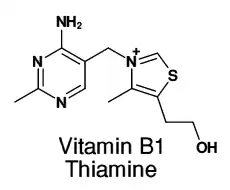
These percentages are generally followed because if you exceed with fish there is a risk of overdosing on the thiaminase enzyme which destroys Vit.B1.
So I always advise you to administer them in rotation.
- It is an anti-vitamin B1 and is an enzyme that destroys thiamine.
- Vitamin B1 also plays a key role in supporting neuronal function, at both central and peripheral levels, proving necessary for the correct transmission of nerve stimuli from the brain and spinal cord to the various parts of the body (and vice versa) and for numerous brain functions. In addition, vitamin B1 is essential for the proper functioning of the heart and muscles and our friends are very sensitive to the nutritional deficiencies of this vitamin. Ingestion through daily nutrition is therefore very important.
Thiamine is essential in the energy metabolism of carbohydrates and in a series of non-enzymatic but fundamental activities for neuronal tissues. The active form of the vitamin in the body is thiamine pyrophosphate (TPP). When dogs and cats have physiological deficiencies of TPP the clinical signs are much more rapid than other deficiencies and involve the heart and nervous systems, up to damage to the brain tissues.
Some fish that contain thiaminase
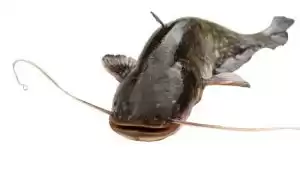
- Anchovies, Agueglie, Bleak, Anchovies, Shadows, Herring, Barbel, Sea bass, Carp, Moray eels, Sea bream, Perch, Trout, Catfish, Stingrays, Turbot, Endive, Mackerel.
Some fish that do not contain thiaminase
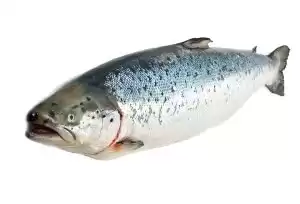
- Perch, lake char, rainbow trout, salmon trout, pike, Atlantic salmon, silver salmon, eel, plaice, cod, amberjack, dogfish
6th step of the barf diet for dogs: Fat
Recommended percentage : 10% – 20%

Fat is a natural fuel source in the dog barf diet that activates a process called gluconeogenesis (conversion of proteins and fats into glucose).
Better not to over-administer it because an excess of glucose would lead to a rise in insulin causing health problems such as diabetes.
- The fat that you can use is found in white meat like chicken skin and red meat.
We have decided to facilitate the transition to the barf diet for dogs by creating a specific calculator for your four-legged friend !!
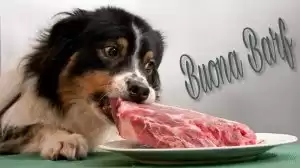
Now have you figured out how to make the switch to the barf diet for dogs?
Frequently Asked Questions-
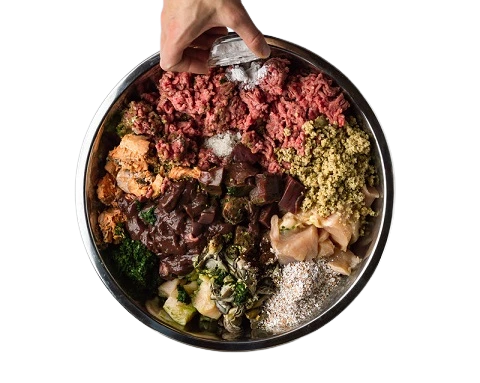
What is the BARF?
BARF is an acronym that commonly refers to Biologically Appropriate Raw Food. In practice, this diet contains the idea of feeding the dog based on its original diet as a carnivorous animal, which eats raw meat.
In practice, the diet is based on fresh meat, offal, vegetables, and vitamin supplements, to try to mimic the composition of the dog’s natural prey as much as possible.
Why choose BARF?
Since this is a very different type of diet from the classic choice of ready-made and pre-packaged dog food, raw feeding divides. There are many owners and vets who recommend it and just as many who strongly disapprove of it.
The owners who choose it say that thanks to the BARF their furry dogs have healthy teeth (due to the prolonged chewing of fresh meat), a nice shiny coat, much fewer problems with the joints, and in general a healthier and stronger musculoskeletal system. also at the level of tendons and ligaments.
Choosing a raw diet means giving your dog a food tailor-made for him, without chemical additives or preservatives. No wonder this choice offers several benefits, especially for dogs with specific health problems and nutritional needs.
How does the BARF feeding work?
The BARF diet is composed of variable percentages of the various foods, which change according to the line of thought and the needs of the animal. Generally, the supply of boneless meat represents the largest percentage, followed by meaty bones, green tripe and organs, and offal in equal quantities.
What should I pay attention to if I choose the BARF for my dog?
If you decide to feed your dog on a home-cooked raw food diet, you can’t just put bits of muscle meat in your furry’s bowl and think that’s okay.
Risks that over time suffer from food shortages, even serious ones. If you want your dog to get everything he needs, you need to accurately calculate the amount of offal, vegetables, vitamins, and minerals he needs daily.
In this sense, BARF is a food style that requires a certain commitment. Thankfully, many dog food manufacturers and butchers have moved to meet the growing demand from dog owners who want to choose a more natural type of food for their pets.
The ready-made foods for the BARF diet for dogs are formulated correctly and assembled directly by the manufacturer or by the butcher, and then frozen: at that point, just defrost them to give your dog a complete, balanced and healthy meal.
Many supporters of this type of diet introduce BARF from the first weeks of the dog’s life, after weaning: obviously, a puppy has very different nutritional needs from those of an adult dog, and therefore it is necessary to seek advice on the rations and composition of the meals.
Choosing the BARF: where to start
1. Evaluate the effort needed and get advice:
BARF is a rather elaborate style of food. You have to learn how to plan the purchase and storage of raw meat and you have to learn how to mix the various ingredients precisely. It is best to consult before you begin, to have him visit your dog and be told exactly what nutrients your dog needs and in what quantities. Also, find out what type of BARF you intend to follow: there are different schools of thought and approaches, and there is no single BARF diet.
2. Choose your raw meat carefully:
Before you begin, you should be well informed about what kind of raw meat to put in your dog’s bowl. Do some research online. Not all offal is good: liver and kidneys, for example, contain toxic substances, which is why these two parts of beef and veal should only be included in your dog’s diet once a week. Pork cannot be included in your pet’s raw diet: it can transmit the dangerous Aujeszky’s disease, which is fatal to dogs.
3. Watch out for the bones!
Always be careful to choose animal bones that do not break, this is to prevent your dog from being seriously injured or worse.
4. Make sure your diet is varied:
Avoid giving your dog only and always muscle meat. Your dog also needs offal, bones, oils, fruits, and vegetables (chopped or pureed). Remember that not all fruit is good: there are also vegetables and fruits that are toxic to dogs.
What are the benefits of the BARF diet for your dog
Among the advantages of the natural diet you will notice:
✅ Increase in energy and vitality
✅ Eating raw food also helps to avoid bad breath in dogs caused by bacteria
✅ Increase in muscle mass
✅ Disappearance of dental problems and oral hygiene
✅ Disappearance of skin problems and ear infections
✅ Improvement and, at times, the disappearance of arthritis and joint problems
✅ Greater hydration
✅ Greater resistance to internal and external parasites etc.
